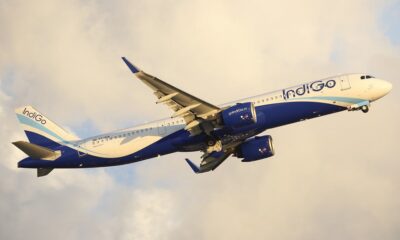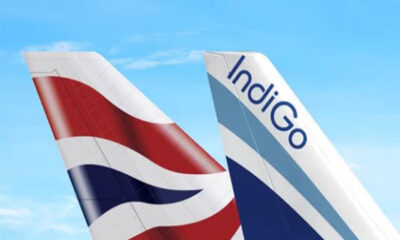Aerospace
IndiGo sets 30,000 feet altitude limit for Airbus A320neos to reduce engine strain.

New Delhi: InterGlobe Aviation Ltd-run IndiGo and Go Airlines (India) Ltd-run GoAir, among to first to fly the new Airbus A320neo, have been forced to find ways to deal with vexing technical snags with the Pratt & Whitney engines that power the aircraft.
IndiGo has asked its pilots to fly snag-hit A320neo planes at a lower altitude, 30,000 feet, and not the usual 36,000 feet, to reduce strain on engines even though it will mean higher fuel burn. GoAir CEO Wolfgang Prock-Schauer said in an interview in February that Pratt & Whitney “will support us properly with spare engines and other support needs to be there so we can overcome the initial phase and don’t have any flight disruptions”.
A Pratt & Whitney spokesman said it has no comment on the subject.
Earlier this month, the engine maker said there were no safety issues in the planes and replacement engines were being sent to India when required. Still, the Directorate General of Civil Aviation (DGCA) has asked IndiGo and GoAir to increase surveillance of these planes, besides specifying other restrictions on when and where to fly them.
In January, an IndiGo flight had a so-called rejected take-off at Mumbai. In February, a GoAir flight from Delhi had to return to the airport after an engine fire 15 minutes into the flight. In the same month, a GoAir flight had to make an emergency landing and an IndiGo flight had to fly minus passengers to Delhi from Baroda.
Spokespersons for GoAir and IndiGo declined to comment for this story.
Analysts say the two airlines are facing teething troubles that early buyers of new aircraft do. They point to Air India’s troubles with Boeing’s Dreamliner. Usually, such problems are sorted out within the first two years of a new aircraft being launched.
In this case too, “technical issues will be sorted out in one-and-a-half years”, Prock-Schauer said.
IndiGo, which was the launch customer for the A320neo, has about 411 planes on order; it has so far inducted 19 in its 131-plane fleet. GoAir flies less than half-a-dozen of them and has about 140 on order. The planes, powered by fuel-efficient engines, are key to both airlines’ low cost model.
On 21 March, Ashim Mittra, vice-president (flight operations), IndiGo, said in a note to pilots that Pratt & Whitney had proposed limiting the altitude of flying to 30,000 feet for A320neo planes to avoid a possible glitch in the engine lubrication system and that, effective 22 March, IndiGo had decided to adopt the recommendation. Mint has seen a copy of the note. Since flying at lower altitudes consumes more fuel, the note asked pilots to fuel up accordingly.
Courtesy : Live mint

Aerospace
Indigo will soon launch Air Taxi Service in India

InterGlobe Enterprises, the parent brand of IndiGo, is set to revolutionize travel in India with its upcoming air taxi service.
Scheduled for a potential launch in 2026, this innovative venture promises a seamless journey for passengers between two bustling hubs. Delhi and Gurgaon in Haryana. The forthcoming service is projected to revolutionize the daily commute, offering passengers a swift aerial journey covering the distance in a mere 7 minutes.
This remarkable efficiency contrasts starkly with the conventional 90-minute drive, underscoring the immense time-saving potential for commuters. The anticipated fare, ranging from Rs 2,000-3,000, makes this innovative mode of transport not only swift but also remarkably competitive in pricing.
At the heart of this ambitious endeavor lies a strategic partnership with Archer Aviation, a pioneer in electric vertical takeoff and landing (eVTOL) aircraft technology. Under this collaboration, Archer will supply 200 state-of-the-art eVTOL aircraft, representing an investment of US$ 1 billion. These cutting-edge aircraft, capable of accommodating up to four passengers alongside the pilot, epitomize the future of sustainable air travel.
Powered by six battery packs, Archer’s eVTOL aircraft boast rapid charging capabilities, enabling a swift turnaround between flights. With a charging time of just 30-40 minutes, these eco-friendly aircraft ensure minimal downtime, maximizing operational efficiency.
Similar services are anticipated to be introduced by the joint venture in Bengaluru and Mumbai as well. Nevertheless, the service rollout period has not yet been made public by the company. Next year, it is anticipated to get its certification. Following this, the company will start the certification procedure with the Directorate General of Civil Aviation (DGCA).
Aerospace
Which is bigger 777x or 787 aircraft ?

The 777X is a new series of the Boeing 777 family and is designed to be larger and more efficient than its predecessor. It features two variants: the 777-8 and the 777-9, being the larger of the two.
The Boeing 777X emerges as the larger sibling within the Boeing family, representing a significant leap forward in both size and efficiency. Comprising two variants, the 777-8 and the 777-9, the latter takes the crown as the larger of the two. With its expansive fuselage and impressive wingspan, the 777X is tailored for long-range journeys and boasts a substantial passenger capacity.
On the other hand, the Boeing 787, affectionately known as the Dreamliner, occupies a niche in the market as a smaller yet formidable aircraft designed for medium to long-range flights. Its distinguishing feature lies in its composite fuselage, a technological marvel that renders it lighter and more fuel-efficient compared to conventional aluminum counterparts. The Boeing 777X is larger than the Boeing 787 aircraft.
When it comes to passenger capacity, the 777-9 reigns supreme, typically accommodating a sizeable contingent of 400-425 passengers in its standard configuration. In contrast, the 787, with its more modest dimensions, typically carries between 240-290 passengers, depending on the variant and layout.
One of the remarkable innovations introduced with the 777X is its folding wingtips, a feature designed to address the logistical challenges of accommodating such a large aircraft in conventional airport gates. These folding wingtips enable the 777X to retract its wings, allowing it to fit into gates designed for smaller aircraft while still reaping the benefits of an extended wingspan during flight, thereby enhancing fuel efficiency and operational flexibility
Aerospace
China Secures Production Certificate for Mass Production of Pilotless eVTOL Aircraft

The first passenger-carrying pilotless electric vertical takeoff and landing (eVTOL) aircraft in the world, the EH216-S, has received the Production Certificate for its eVTOL aircraft from the Civil Aviation Administration of China (CAAC).
This is a significant milestone for EHang Holdings Limited, the leading UAM technology platform company in the world. This outstanding accomplishment is another big step towards mass manufacturing for the eVTOL aircraft and the ensuing commercial operations, building on the ground-breaking acquisition of the Type Certificate and the Standard Airworthiness Certificate for the EH216-S.
The PC is a crucial certificate that the aircraft maker receives from the CAAC, the country’s aviation authority. By obtaining this certificate, EHang has demonstrated that it has set up a quality management system for mass production that satisfies the airworthiness regulation standards set forth by the CAAC, and the company has been given permission to continue producing mass quantities.
It is also a strong guarantee of the calibre of the goods made by EHang. Raw materials, supplier management, manufacturing organisation, production quality control, aircraft pre-delivery test, after-sales repair and maintenance, etc. are all included in the mass production quality management system for the EH216-S.
To ensure that every aircraft and its components that roll off the production line strictly adhere to the approved type design and safety requirements, the system sets clear guidelines and documentation for every step in the production procedure. This ensures comprehensive traceability and safety control.



























